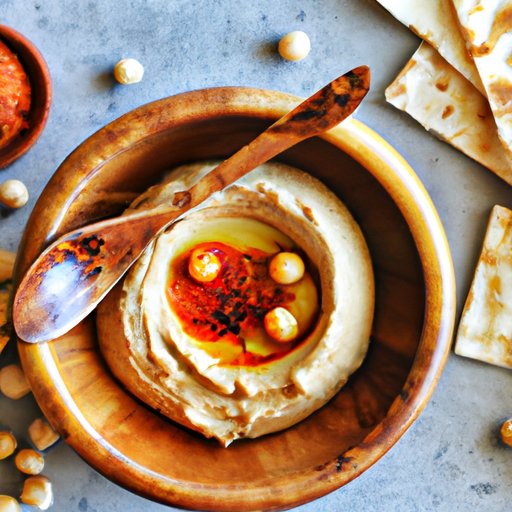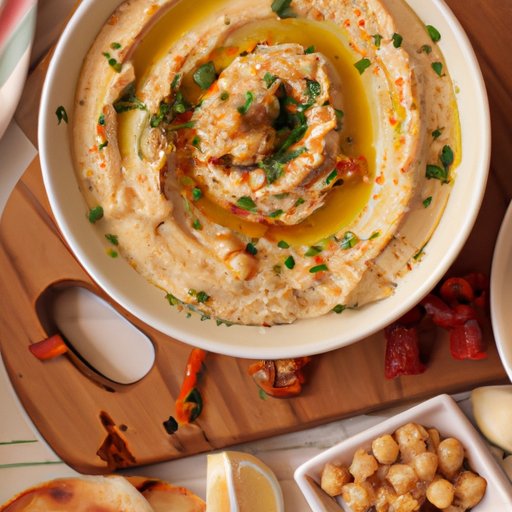I. Introduction
Hummus is a delicious and healthy Middle Eastern dip made from chickpeas, tahini, olive oil, lemon juice, and garlic. Making hummus at home is not only cheaper, but also allows you to control the ingredients, customize the flavors, and experiment with unique variations. In this article, we will provide a step-by-step guide to making hummus from scratch, offer five variations of hummus recipes for a healthy snack, discuss the health benefits of hummus, reveal the secret to making creamy hummus at home, and share tips for storing and preserving your homemade hummus. We will also provide creative serving suggestions for incorporating hummus into your meals.
II. Step-by-Step Guide to Making Hummus from Scratch
Before we get into the variations of hummus, let’s start with the basic recipe for making hummus from scratch. Here are the step-by-step instructions:
A. Ingredients needed
To make hummus, you will need:
- 1 can of chickpeas or 1 cup of cooked chickpeas
- 1/4 cup of tahini paste
- 2 tablespoons of olive oil
- 2 tablespoons of lemon juice
- 1 garlic clove, minced
- 1/4 teaspoon of salt
- 2-3 tablespoons of ice cold water
B. Preparing chickpeas
If using canned chickpeas, rinse and drain them before using. If using dried chickpeas, soak them overnight and then cook them until soft. You can also use a pressure cooker to cook chickpeas more quickly.
C. Blending the hummus
Combine the chickpeas, tahini paste, olive oil, lemon juice, garlic, salt, and 1-2 tablespoons of ice cold water in a food processor. Process for 2-3 minutes until smooth and creamy.
D. Adjusting for taste
Taste the hummus and adjust the seasoning as desired. You can add more salt, lemon juice, or garlic depending on your preference. For a milder taste, use less garlic.
E. Serving suggestions
Transfer the hummus to a serving bowl and drizzle with olive oil and paprika. You can also sprinkle chopped parsley or cilantro on top. Serve with pita bread, crackers, or vegetables for dipping.
III. 5 Variations of Hummus Recipes for a Healthy Snack
Now that you know how to make basic hummus, let’s add some flavor and variety to it. Here are five variations of hummus recipes to try:
A. Roasted Red Pepper Hummus
Add 1/2 cup of roasted red peppers (drained if using from a jar) to the basic hummus recipe and blend until smooth. You can also add a pinch of smoked paprika or cayenne pepper for extra flavor.
B. Garlic Hummus
Add an extra garlic clove or two to the basic hummus recipe for a stronger garlic flavor. You can also roast the garlic beforehand for a more mellow taste.
C. Spicy Hummus
Add 1-2 chopped jalapeno peppers or a pinch of cayenne pepper to the basic hummus recipe for a spicy kick. You can also add a tablespoon of hot sauce or harissa paste.
D. Sweet Potato Hummus
Replace the chickpeas with cooked sweet potato for a sweeter and creamier hummus. You can also add cinnamon, nutmeg, or maple syrup for extra sweetness.
E. Lemon and Dill Hummus
Replace the garlic with 1-2 tablespoons of chopped fresh dill and add the zest of one lemon to the basic hummus recipe for a refreshing and tangy flavor.
IV. Health Benefits of Hummus and How to Incorporate It into Your Diet
Hummus is not only delicious, but also packed with nutrients and health benefits. Here are some reasons why you should incorporate hummus into your diet:
A. Protein
Chickpeas are a great source of plant-based protein, with 7.3 grams per 100 grams of cooked chickpeas. Adding hummus to your meals can help you meet your daily protein needs and keep you full and satisfied.
B. Fiber
Chickpeas are also high in fiber, with 2.8 grams per 100 grams of cooked chickpeas. Fiber helps regulate digestion, prevent constipation, and lower cholesterol levels.
C. Vitamins
Hummus is a good source of various vitamins and minerals, such as iron, folate, magnesium, and vitamin B6. These nutrients are essential for maintaining healthy blood cells, brain function, and energy levels.
D. Uses for Hummus in meals
Hummus is a versatile ingredient that can be used in many different ways in meals. You can spread it on toast, use it as a dip for vegetables or crackers, add it to sandwiches or wraps, top it on salads, or mix it with avocado for a unique guacamole.
E. Benefits for cardiovascular disease, diabetes, and digestion
Studies have shown that consuming hummus regularly can help reduce the risk of cardiovascular disease, lower blood sugar levels in individuals with diabetes, and improve digestion and gut health.
V. Spice Up Your Hummus Recipe with These Unique Ingredients
Looking to add more flavor and texture to your hummus? Here are some unique ingredients to try:
A. Olive Oil
Drizzle extra virgin olive oil on top of your hummus for a fruity and nutty flavor. You can also use flavored olive oils, such as garlic or basil, for a more intense taste.
B. Tahini paste
Increase the amount of tahini paste in your hummus for a creamier and richer texture. You can also use black sesame or almond butter for a unique twist.
C. Lemon and lime zest
Add the zest of one lemon or lime to your hummus for a bright and citrusy flavor. You can also add the juice for extra tanginess.
D. Walnut oil
Replace the olive oil with walnut oil for a nutty and earthy taste. You can also add chopped walnuts to the top of your hummus for crunch.
E. Cumin
For a warm and aromatic flavor, add a teaspoon of ground cumin to your hummus. You can also sprinkle cumin seeds on top for a visual appeal.
VI. Secret to Making Creamy Hummus at Home
One of the challenges of making hummus at home is achieving a smooth and creamy texture. Here are some tips for making creamy hummus:
A. Adding ice cold water
Using ice cold water instead of room temperature water can help emulsify the ingredients and make the hummus smoother. You can also add ice cubes directly to the food processor.
B. Skinning the chickpeas
If you have the time and patience, you can remove the skin from each chickpea for a smoother hummus. This requires pinching each chickpea between your fingers and popping out the skin.
C. Longer blending time
Blending the hummus for a longer time (5-10 minutes) can help break down the chickpeas and tahini paste more thoroughly. Just make sure to scrape down the sides of the food processor occasionally.
VII. Tips for Storing and Preserving Your Homemade Hummus
If you have leftover hummus or want to make a batch ahead of time, here are some tips for storing and preserving it:
A. Refrigeration
Store your hummus in an airtight container in the refrigerator for up to a week. You can also add a layer of olive oil on top to prevent drying out and oxidizing.
B. Keeping it airtight
Avoid leaving your hummus out at room temperature for extended periods of time, as it can spoil quickly. Make sure to keep it sealed tightly when not in use.
C. Preparing for storage
Before storing your hummus, make sure to smooth out the surface with a spatula or spoon. This can help prevent air pockets and preserve the flavor and texture of the hummus.
D. Freezing hummus
You can also freeze your hummus for up to three months. Just make sure to store it in a freezer-safe container and thaw it in the refrigerator overnight before using.

VIII. Serving Suggestions and Creative Ways to Use Hummus in Your Meals
Now that you have made your hummus and know how to preserve it, here are some creative serving suggestions and ways to use hummus in your meals:
A. Use as a dip
Dip pita chips, crackers, or vegetables into your hummus for a healthy and satisfying snack.
B. Spread hummus on sandwiches and wraps
Replace mayo or other spreads with hummus to add flavor and nutrition to your sandwiches and wraps.
C. Top hummus on pizza
Instead of tomato sauce, spread hummus on your pizza crust and top with veggies, cheese, and meat for a Middle Eastern twist.
D. Use in salad dressings
Blend hummus with lemon juice, olive oil, and vinegar to make a creamy and healthy salad dressing.
E. Mix with avocado for a unique guacamole
Mash together hummus and avocado for a delicious and creamy dip for chips or vegetable sticks.
IX. Conclusion
We hope this article has inspired you to make homemade hummus and experiment with different flavors and variations. Making hummus at home is not only easy and affordable, but also allows you to enjoy all the health benefits and versatility of this delicious dip. Remember to use our tips for making creamy hummus, storing and preserving your hummus, and incorporating hummus into your meals. Happy hummus making!
A. Recap of the article
This article provides a step-by-step guide to making hummus from scratch, offers five variations of hummus recipes for a healthy snack, discusses the health benefits and uses of hummus, reveals the secret to making creamy hummus at home, shares tips for storing and preserving your homemade hummus, and provides creative serving suggestions for incorporating hummus into your meals.
B. Encouragement to make homemade hummus
Making hummus at home is not only a fun and easy activity, but also a way to control the ingredients and customize the flavors. Plus, you can save money and reduce waste by making hummus from scratch. Give it a try and impress your friends and family with your hummus-making skills!
C. Reminder of benefits of making hummus at home
Making hummus at home allows you to control the ingredients, experiment with unique flavors, and enjoy all the health benefits of this delicious dip. It’s also a fun and affordable activity that can be shared with friends and loved ones.
